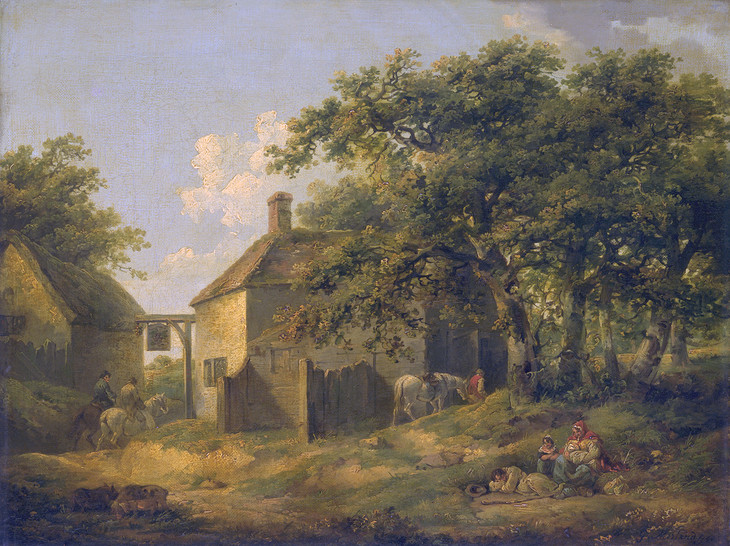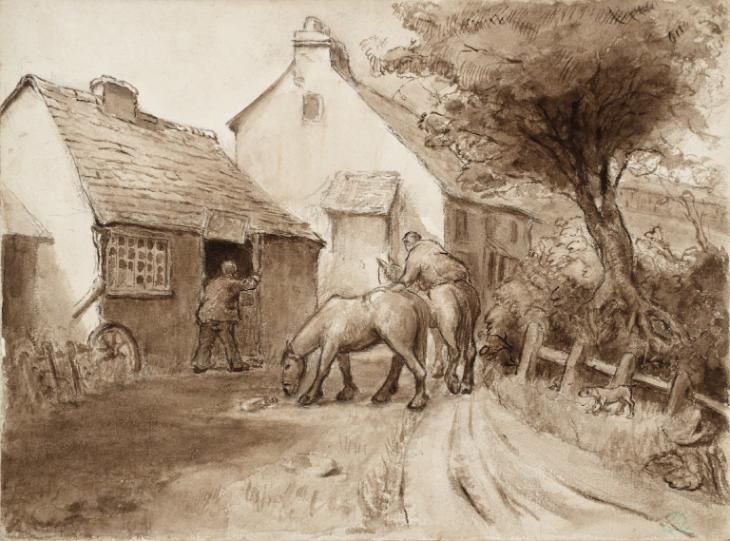Spencer Gore The Blacksmith's Shop c.1903
Spencer Gore,
The Blacksmith's Shop
c.1903
Gore’s watercolour depicts a rural scene still common in turn-of-the-century Britain, slowly undergoing modernisation. His traditional draughtsmanship recalls English watercolours of the eighteenth century.
Spencer Gore 1878–1914
The Blacksmith’s Shop
c.1903
Graphite and watercolour on paper
225 x 304 mm
Inscribed by ?Albert Rutherston ‘Spencer F. Gore. Circa 1903. Given by him to Albert Rutherston’ on back; stamped ‘AR’ monogram in green ink bottom right, the collection stamp of Albert Rutherston.
Presented by Albert Rutherston 1941
N05263
c.1903
Graphite and watercolour on paper
225 x 304 mm
Inscribed by ?Albert Rutherston ‘Spencer F. Gore. Circa 1903. Given by him to Albert Rutherston’ on back; stamped ‘AR’ monogram in green ink bottom right, the collection stamp of Albert Rutherston.
Presented by Albert Rutherston 1941
N05263
Ownership history
Given by the artist to Albert Rutherston (1881–1953), by whom presented to Tate Gallery 1941.
References
1964
Mary Chamot, Dennis Farr and Martin Butlin, Tate Gallery Catalogues: The Modern British Paintings, Drawings and Sculpture, vol.1, London 1964, p.247.
Technique and condition
The Blacksmith’s Shop is executed in graphite with watercolour on wove paper. The paper is white, heavy in weight, of good quality and has a slight texture to the surface. All edges are cut straight suggesting that the sheet was loose leaf and not from a sketchbook. The image is drawn on the full size of the paper. The soft pencil drawing is slightly smudged in places and is overpainted with thin washes and dryer brushstrokes of dark brown monochrome watercolour.
Gore studied drawing at the Slade School of Fine Arts under Henry Tonks from 1896–9. Few drawings from this period exist and his friend and fellow student Albert Rutherston commented that Gore was not particularly good at drawing at the time.1 He did not believe in learning ‘a lot of directions and rules and hints and theories about drawing’, but rather adhered to three key principles: ‘light and shade, the sculptors idea of a drawing. contour and light and shade [sic]’.2
Tomoko Kawamura
June 2004
Notes
How to cite
Tomoko Kawamura, 'Technique and Condition', June 2004, in Robert Upstone, ‘The Blacksmith’s Shop c.1903 by Spencer Gore’, catalogue entry, May 2009, in Helena Bonett, Ysanne Holt, Jennifer Mundy (eds.), The Camden Town Group in Context, Tate Research Publication, May 2012, https://wwwEntry
The back of this drawing is inscribed, probably by Albert Rutherston: ‘Spencer F. Gore. Circa 1903. Given by him to Albert Rutherston’. This is the only specific information about the drawing, and it is not known either where the scene is, or whether the drawing was part of some series.
Gore and Rutherston were friends from their time together at the Slade School of Fine Art, even though Rutherston was three years younger. All three drawings by Gore in Tate’s collection were presented by Rutherston (see N05307 and N06016). Gore left the Slade in 1899 and very little is known about this earliest phase in his development as an artist. He spent the winter of 1902–3 in Madrid, Spain, where he went with Wyndham Lewis, another Slade friend. They stayed with a Mrs Briggs at 92 Calle Mayor Tercero1 and, unknowingly, they appear to have been in the city at the same time as Harold Gilman. Gore and Rutherston formed a close friendship and seem to have shared artistic ideals in the very first years of the century. Both were interested in the possibility of the theatre in their art, and Rutherston used working women as the subject of pictures such as The Song of the Shirt 1902 (Bradford City Art Gallery)2 and The Laundry Girls 1906 (Tate N04996). In 1902 Rutherston painted Gore’s portrait (National Portrait Gallery, London).3

George Morland 1763–1804
Roadside Inn 1790
Oil on canvas
support: 511 x 664 mm
Tate N02641
Bequeathed by George Salting 1910
Fig.1
George Morland
Roadside Inn 1790
Tate N02641
The manner of Gore’s draughtsmanship in this drawing is absolutely traditional, if a little awkward in places. There is no suggestion of the stylised forms that would appear in his landscapes at Letchworth Garden City ten years later. Instead, with its soft, feathery foliage and gnarled tree roots, parts of the drawing recall English watercolours of the eighteenth century or the landscape sketches of Thomas Gainsborough.
Robert Upstone
May 2009
Notes
Richard Shone, ‘Spencer Frederick Gore’, in Spencer Frederick Gore 1878–1914, exhibition catalogue, Anthony d’Offay Gallery, London 1983, n.p.
National Portrait Gallery NPG 3320; reproduced in R.M.Y. Gleadowe, Albert Rutherston, London 1925, pl.3, and at the National Portrait Gallery, London, http://www.npg.org.uk/collections/search/largerimage.php?LinkID=mp01829&role=sit&rNo=0 , accessed 14 February 2011.
Related biographies
Related essays
Related reviews and articles
- Albert Rutherston, ‘From Orpen and Gore to the Camden Town Group’ The Burlington Magazine, vol.83, no.485, August 1943, pp.201–5.
How to cite
Robert Upstone, ‘The Blacksmith’s Shop c.1903 by Spencer Gore’, catalogue entry, May 2009, in Helena Bonett, Ysanne Holt, Jennifer Mundy (eds.), The Camden Town Group in Context, Tate Research Publication, May 2012, https://www



